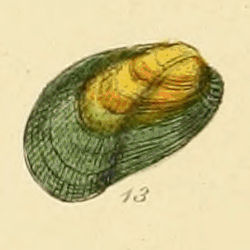Green bean clam
| Green bean clam | ||||||||||||
|---|---|---|---|---|---|---|---|---|---|---|---|---|

Green bean clam ( discors muscle ) |
||||||||||||
| Systematics | ||||||||||||
|
||||||||||||
| Scientific name | ||||||||||||
| Discors muscle | ||||||||||||
| ( Linnaeus , 1767) |
The green bean mussel ( Musculus discors ) is a type of mussel from the mussel family (Mytilidae). It is the type species of the genus Musculus .
features
The case is elongated ovoid to slightly rhombic in outline and about twice as long as it is high. The lower edge of the case is almost straight. Overall, the housings are up to about 35 mm long. The vertebra sits near the front end. Two radial fields extend from the vertebra, a front and a rear field. The front panel has nine to twelve radial ribs and the rear panel has 30 to 35 radial ribs. Within these fields, the edge of the housing is notched by the ribs that end there. The border between the rear radial field and the non-ribbed central field is reinforced like a keel. The keel ends at the edge of the housing in a small bulge. The outside sculpture is imprinted on the inside. The growth strips are only weakly developed. The comparatively thin periostracum is light olive green. If the peristracum is removed, the shell is light brownish. The inside has a pearly sheen. The lock is toothless, the surface line is not indented.
Geographical distribution and way of life
The mussel species, which is quite common in their habitat, occurs on the east side of the Atlantic from the Arctic to the Cape Verde Islands . On the west side of the Atlantic from the Arctic to the Long Island Sound . In the northern Pacific from the Aleutian Islands to Puget Sound and northern Japan . It also lives on the edge of the North Sea and penetrates the western Baltic Sea . It is also found in the eastern Mediterranean .
The green bean clam lives with byssus threads attached to stones or algae, often in the roots of Laminaria or between Corallina officinalis . Older animals are woven into a real byssus nest. It occurs in very shallow water to a depth of around 20 m.
Taxonomy
The taxon was introduced into scientific literature by Carl von Linné in 1767. It is the type of the genus Musculus Röding, 1798 by subsequent determination.
literature
- Rudolf Kilias: Lexicon marine mussels and snails. 2nd edition, Verlag Eugen Ulmer, Stuttgart 1997, ISBN 3-8001-7332-8 , p. 206
- Guido Poppe and Yoshihiro Goto: European Seashells Volume 2 (Scaphopoda, Bivalvia, Cephalopoda) . 221 pp., Verlag Christa Hemmen, Wiesbaden 1993 (2000 unc. Reprint), ISBN 3925919104 , p. 51
- Rainer Willmann: Mussels and snails of the North and Baltic Seas. 310 pp., Neumann-Neudamm, Melsungen 1989, ISBN 3-7888-0555-2 , pp. 100, 102
- S. Peter Dance, Rudo von Cosel (arrangement of the German edition): The great book of sea shells. 304 p., Verlag Eugen Ulmer, Stuttgart 1977, ISBN 3-8001-7000-0 , p. 227
Individual evidence
- ↑ Mesut Önen, Alper Doğan: Dacrydium hyalinum (Monterosato, 1875) and Musculus discors (Linnaeus, 1767): Two New Mytilidae (Bivalvia) Species for the Turkish Mollusc Fauna. Turkish Journal of Zoology, 31: 235-239, 2007 PDF
- ^ Carl von Linné: Systema naturæ, Tom. I. Pars II. Editio duodecima reformata. P. 533–1327, Holmiæ / Stockholm, Salvius, 1767 Online at Göttingen Digitization Center (p. 1159 as Mytilus discors ).
- ^ World Register of Marine Species
